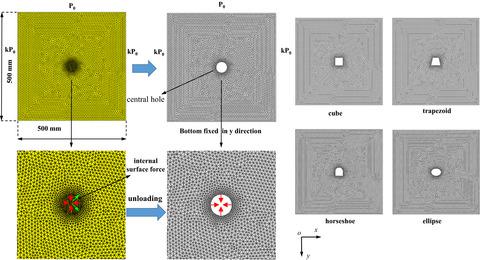当前位置:
X-MOL 学术
›
Energy Sci. Eng.
›
论文详情
Our official English website, www.x-mol.net, welcomes your
feedback! (Note: you will need to create a separate account there.)
Analysis of fractures of a hard rock specimen via unloading of central hole with different sectional shapes
Energy Science & Engineering ( IF 3.5 ) Pub Date : 2019-08-16 , DOI: 10.1002/ese3.432 Fan Feng 1, 2 , Shaojie Chen 1 , Diyuan Li 3 , Songtao Hu 4 , Wanpeng Huang 1 , Bo Li 1
Energy Science & Engineering ( IF 3.5 ) Pub Date : 2019-08-16 , DOI: 10.1002/ese3.432 Fan Feng 1, 2 , Shaojie Chen 1 , Diyuan Li 3 , Songtao Hu 4 , Wanpeng Huang 1 , Bo Li 1
Affiliation

|
Hard rock failure and rockburst hazards under high in situ stresses have been the subject of deep rock mechanics and engineering. Previous investigations employed cubic rock specimens with a central hole for simulation of rock fracturing around deep tunnels at a laboratory scale, while the failure characteristics and crack evolution behavior around different shapes of holes induced by excavation unloading response have been barely considered. A commercially combined finite‐discrete element method (combined FEM/DEM) was used to investigate the failure characteristics and crack propagation process of typical hard rock specimens (marble) via the unloading of central hole with different shapes. Rock heterogeneity was also considered in the model in combination with the engineering reality. The combined FEM/DEM approach was first validated by simulating uniaxial compression and Brazilian tests. Then, the parametrical analysis was conducted in detail on the basis of five different sectional shapes of central holes, including a circle, ellipse, U‐shape, trapezoid, and cube, and two lateral pressure coefficients. Analysis of crack propagation paths, released strain energy, displacement, and average velocity distribution of the monitoring points around the central hole suggests that the failure degree and destruction intensity are strongly related to the sectional shape and lateral pressure coefficients. Hard and brittle rock failure induced by the excavation unloading effect can be classified as stable failure (slabbing failure) and unstable failure (strain rockburst). The cubic, trapezoidal, and U‐shaped holes within the specimen are the most likely to induce unstable failure, while stable failure is the dominant failure pattern around circular and elliptical holes. The lateral pressure coefficient λ was also found to affect failure position and intensity (only for the axisymmetric section) around the central hole. The influence of rock heterogeneity on failure intensity and range around the central hole within the specimen was also discussed. This study emphasizes the importance and necessity of the excavation unloading effect when evaluating surrounding rock failure around deep tunnels.
中文翻译:

不同截面形状的中心孔卸荷对硬岩标本的断裂分析
高地应力下的坚硬岩石破坏和岩爆危险已成为深部岩石力学和工程学的主题。以前的研究采用具有中心孔的立方岩石标本,以模拟实验室规模的深部隧道周围的岩石破裂,而几乎没有考虑由于开挖卸载反应引起的不同形状的孔周围的破坏特征和裂纹扩展行为。商业上采用有限元离散组合方法(FEM / DEM组合),通过卸载不同形状的中心孔来研究典型硬岩标本(大理石)的破坏特征和裂纹扩展过程。该模型还结合工程实际考虑了岩石异质性。首次通过模拟单轴压缩和巴西试验验证了FEM / DEM组合方法的有效性。然后,根据中心孔的五个不同截面形状(包括圆形,椭圆形,U形,梯形和立方体)和两个侧向压力系数,详细进行参数分析。对裂纹扩展路径,释放的应变能,位移以及中心孔周围监测点的平均速度分布的分析表明,破坏程度和破坏强度与截面形状和侧向压力系数密切相关。开挖卸荷效应引起的坚硬脆性岩石破坏可分为稳定破坏(板岩破坏)和不稳定破坏(应变岩爆)。立方,梯形,样品中的U型和U型孔最有可能引起不稳定破坏,而稳定破坏是圆形和椭圆形孔周围的主要破坏模式。横向压力系数还发现λ会影响中心孔周围的失效位置和强度(仅对于轴对称截面)。还讨论了岩石非均质性对试样中心孔周围的破坏强度和范围的影响。这项研究强调了在评估深埋隧道周围的围岩破坏时开挖卸荷效果的重要性和必要性。
更新日期:2019-08-16
中文翻译:

不同截面形状的中心孔卸荷对硬岩标本的断裂分析
高地应力下的坚硬岩石破坏和岩爆危险已成为深部岩石力学和工程学的主题。以前的研究采用具有中心孔的立方岩石标本,以模拟实验室规模的深部隧道周围的岩石破裂,而几乎没有考虑由于开挖卸载反应引起的不同形状的孔周围的破坏特征和裂纹扩展行为。商业上采用有限元离散组合方法(FEM / DEM组合),通过卸载不同形状的中心孔来研究典型硬岩标本(大理石)的破坏特征和裂纹扩展过程。该模型还结合工程实际考虑了岩石异质性。首次通过模拟单轴压缩和巴西试验验证了FEM / DEM组合方法的有效性。然后,根据中心孔的五个不同截面形状(包括圆形,椭圆形,U形,梯形和立方体)和两个侧向压力系数,详细进行参数分析。对裂纹扩展路径,释放的应变能,位移以及中心孔周围监测点的平均速度分布的分析表明,破坏程度和破坏强度与截面形状和侧向压力系数密切相关。开挖卸荷效应引起的坚硬脆性岩石破坏可分为稳定破坏(板岩破坏)和不稳定破坏(应变岩爆)。立方,梯形,样品中的U型和U型孔最有可能引起不稳定破坏,而稳定破坏是圆形和椭圆形孔周围的主要破坏模式。横向压力系数还发现λ会影响中心孔周围的失效位置和强度(仅对于轴对称截面)。还讨论了岩石非均质性对试样中心孔周围的破坏强度和范围的影响。这项研究强调了在评估深埋隧道周围的围岩破坏时开挖卸荷效果的重要性和必要性。











































 京公网安备 11010802027423号
京公网安备 11010802027423号